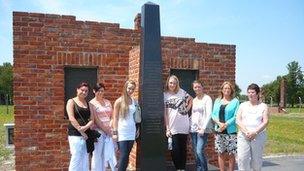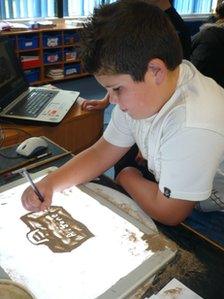Gypsy Auschwitz short film premiere at Milford Haven
- Published
A film about the fate of Gypsies in the Holocaust, made by young people from Pembrokeshire's Gypsy and traveller community, is to have its premiere.
Members of the Priory Project, Monkton, visited the former Auschwitz-Birkenau death camps where 20,000 Roma Gypsies were killed during World War II.
Their seven minute film, Gypsies in Auschwitz, will be shown at Milford Haven's Torch Theatre at 17:30 GMT.
Partly animated, it will be included in a resource pack for Welsh schools.
Between 1941 and 1944, some 23,000 European Roma people were transported to the Auschwitz-Birkenau death camps by the Nazis. Only 2,000 survived.
Twelve young women involved with the Priory Project, which works with 204 children from the community who are integrated into 10 schools in the county, went on the trip to Poland in July.
Aged between 17 and 18, they visited both camps, obtaining special permission to film there.
The idea for the film came after members of Pembrokeshire's Gypsy and traveller community were invited to Cardiff by First Minister Carwyn Jones to say a prayer on Holocaust Memorial Day last January.
Bev Stephens, head of the Gypsy and traveller education service in Pembrokeshire, explained: "Coming back in the car afterwards the girls came up with the idea of visiting Auschwitz."
The trip and film were made with funding from the Save The Children Fund and Film Agency Wales.
"We had to get special permission to film but we felt it was important that for all those young people who wouldn't be able to go to have some understanding of what it was about," said Ms Stephens.
"There is very little information on the Gypsy Roma story at Auschwitz."
'Understanding'
For the group of 12 the experience proved "very harrowing," she said. "There were times when they were absolutely sobbing.

The group visited both Auschwitz and Birkenau camps
"I questioned whether I had done the right thing in taking them but they felt that, although it was awful, it was something that everybody should do.
"They had had no real understanding of what had gone on."
The tour was in two parts - first a visit to Auschwitz and then, after a 20-minute journey, a tour of Birkenau.
"As soon as we got into the minibus to go to Birkenau the girls were wanting to phone home," said Ms Stephens. "The most poignant part of the film is those conversations with their families.
"The visit had a huge effect. Some of the girls told me afterwards it had been life-changing.

The film's animation sequences deal metaphorically with what happened at the camps
"For them there was the realisation that, if Britain had lost the war, they would have been the next to go to the camps."
After the trip younger members of the community who had not been on the trip worked on some animated sequences for the film with producer Gerald Conn.
"They created animated sequences, dealing with happened in a metaphorical way, that interact with the documentary footage," said Mr Conn.
Images used include the piles of crutches, spectacles and shoes which can still be found in rooms at Auschwitz.
Mr Conn, who previously worked with the Priory Project on another film, Travelling Harpists, said: "The Welsh government is developing a resource pack for schools on the subject of Gypsies and travellers.
"It's very likely that they will use the film for the resource pack."
- Published29 September 2011
- Published15 November 2010